Podcast
Questions and Answers
What is the phylum of Echinodermata?
What is the phylum of Echinodermata?
Echinodermata
Name the four classes of Echinodermata.
Name the four classes of Echinodermata.
Asteroidea, Ophiuroidea, Crinoidea, Echinoidea, Holothuroidea
Describe the water vascular system of echinoderms. What is it used for?
Describe the water vascular system of echinoderms. What is it used for?
A hydraulic system for locomotion, food and waste transportation, and respiration.
List five traits that unite all members of Echinodermata.
List five traits that unite all members of Echinodermata.
What is the function of the madreporite?
What is the function of the madreporite?
What is the function of the water vascular system?
What is the function of the water vascular system?
In what developmental stage of this phylum do we see the ancestral trait of bilateral symmetry?
In what developmental stage of this phylum do we see the ancestral trait of bilateral symmetry?
Name a derived trait for the phylum Echinodermata.
Name a derived trait for the phylum Echinodermata.
Which class do sea cucumbers belong to?
Which class do sea cucumbers belong to?
What are tube feet adapted for in echinoderms?
What are tube feet adapted for in echinoderms?
Which class in phylum Echinodermata has jointed spines used in movement?
Which class in phylum Echinodermata has jointed spines used in movement?
What is Aristotle's Lantern and what is its function?
What is Aristotle's Lantern and what is its function?
What is a 'test' in echinoderms?
What is a 'test' in echinoderms?
How are tube feet modified for feeding in Holothuroidea?
How are tube feet modified for feeding in Holothuroidea?
Which class has both its mouth and anus on the upper surface of the central disk?
Which class has both its mouth and anus on the upper surface of the central disk?
Describe protostome development.
Describe protostome development.
Describe deuterostome development.
Describe deuterostome development.
What are some ancestral traits of Echinoderms and Chordates?
What are some ancestral traits of Echinoderms and Chordates?
What does the zygote become in coelomate?
What does the zygote become in coelomate?
What does this phylum's name mean?
What does this phylum's name mean?
What is deuterostomy?
What is deuterostomy?
What are some other characteristics of Echinoderms besides deuterostomy?
What are some other characteristics of Echinoderms besides deuterostomy?
What are the five classes of Echinodermata?
What are the five classes of Echinodermata?
What is the ecological importance of Echinoderms?
What is the ecological importance of Echinoderms?
What is the economic importance of Echinoderms?
What is the economic importance of Echinoderms?
Describe Class Asteroidea.
Describe Class Asteroidea.
Describe Class Ophiuroidea.
Describe Class Ophiuroidea.
Describe Class Crinoidea.
Describe Class Crinoidea.
Describe Class Echinoidea.
Describe Class Echinoidea.
Describe Class Holothuroidea.
Describe Class Holothuroidea.
Flashcards
Echinodermata
Echinodermata
A phylum of marine animals including sea stars, sea urchins, and sea cucumbers.
Asteroidea
Asteroidea
Sea stars; characterized by their star-like shape and predatory behavior.
Ophiuroidea
Ophiuroidea
Brittle stars; known for their long, slender, flexible arms used for movement and filter feeding.
Crinoidea
Crinoidea
Signup and view all the flashcards
Echinoidea
Echinoidea
Signup and view all the flashcards
Holothuroidea
Holothuroidea
Signup and view all the flashcards
Water Vascular System
Water Vascular System
Signup and view all the flashcards
Madreporite
Madreporite
Signup and view all the flashcards
Tube Feet
Tube Feet
Signup and view all the flashcards
Endoskeleton
Endoskeleton
Signup and view all the flashcards
Aristotle's Lantern
Aristotle's Lantern
Signup and view all the flashcards
Test
Test
Signup and view all the flashcards
Protostome Development
Protostome Development
Signup and view all the flashcards
Deuterostome Development
Deuterostome Development
Signup and view all the flashcards
Adult symmetry in echinoderms
Adult symmetry in echinoderms
Signup and view all the flashcards
Echinoderm symmetry
Echinoderm symmetry
Signup and view all the flashcards
Study Notes
Echinodermata Overview
- Phylum Echinodermata includes marine animals like sea stars, brittle stars, sea lilies, sea urchins, sand dollars, and sea cucumbers.
Classes of Echinodermata
- Five main classes:
- Asteroidea: Sea stars
- Ophiuroidea: Brittle stars
- Crinoidea: Sea lilies and feather stars
- Echinoidea: Sea urchins and sand dollars
- Holothuroidea: Sea cucumbers
Water Vascular System
- A hydraulic system that aids in locomotion, food and waste transportation, and respiration.
Key Traits
- Pentaradial symmetry
- Tube feet for movement and feeding
- Deuterostome development
- Water vascular system and ambulacral grooves
Madreporite
- Acts as an opening for the water vascular system.
Tube Feet Function
- Adapted for mobility and collecting food, small and flexible.
Developmental Stages
- Larval stage exhibits bilateral symmetry, reflecting an ancestral trait of the phylum.
Derived Traits
- Endoskeleton composed of ossicles provides structural support.
Feeding Mechanisms
- Class Echinoidea has a highly folded cardiac stomach for its predatory feeding method.
Aristotle's Lantern
- A unique feeding structure composed of teeth, allows scraping of algae or consumption of prey.
Test
- A structure formed by ossicles that fuse into a sphere, providing protection and supporting tube feet.
Ecological and Economic Importance
- Echinoderms play a role in controlling algae and are significant for ecosystems known as "ocean deserts." They also contribute to industries through limestone and food sources like sushi.
Class-Specific Characteristics
- Asteroidea: Active predators with adapted tube feet for slow movement and opening clams.
- Ophiuroidea: Characterized by slender, flexible arms; nocturnal scavengers that filter feed.
- Crinoidea: Filter feeders with U-shaped guts; the most ancient class with arms composed of pinnules.
- Echinoidea: Lack arms; round test for protection, movement through tube feet and jointed spines.
- Holothuroidea: Soft-bodied with reduced ossicles, feeding tentacles modified from tube feet, defense mechanisms include expelling sticky tubules.
Development Definitions
- Protostome Development: The mouth develops from the blastopore during early embryonic stages.
- Deuterostome Development: The blastopore becomes the anus, with bilateral symmetry in larval stages.
Ancestral Traits for Echinoderms and Chordates
- Shared traits include true tissues, bilateral symmetry, organ systems, coelomate structures, and a complete digestive tract.
Studying That Suits You
Use AI to generate personalized quizzes and flashcards to suit your learning preferences.




